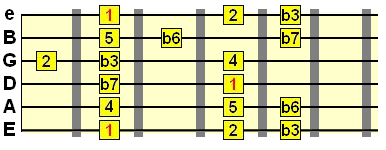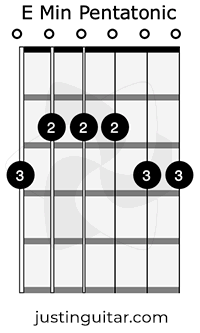E Minor Scale Guitar Positions - E Minor Scale Diagram For Guitar Fingerstyle Guitar Lessons, A minor scale typically has a dark, incomplete, sad sound to it.
E Minor Scale Guitar Positions - E Minor Scale Diagram For Guitar Fingerstyle Guitar Lessons, A minor scale typically has a dark, incomplete, sad sound to it.. And here is the e major scale in the 4th position. All of the root notes are e because this is the e minor pentatonic scale. An a natural minor scale contains the same notes as a c major scale, a d natural minor scale contains the same notes as an f major scale, etc.). The natural a minor scale is made up of the following notes: We will play these five positions in the key of a minor, a very common key for guitar players.
Diagram created with the fachords scales generator. E minor scale positions one way you can learn to play the e minor scale is by using the guitar neck scale diagrams below. Harmonic minor positions on guitar this lesson is a continuation from the harmonic minor scale lesson. This pattern is the trickiest of all as you have to use your little finger! We're going to begin by looking at the a minor pentatonic scale.

The red dots indicate a root note and the black dots indicate a note in the scale.
Like all major scales, the notes of the c major scale can be grouped to form five distinct patterns or positions across the fretboard. All of the root notes are e because this is the e minor pentatonic scale. Available on kindle and paperback. E minor pentatonic scale in open position e minor pentatonic scale in open position in this first single strings guitar lesson, we look at the e minor pentatonic scale in open position (which mean it uses open strings!) this is appropriate as your first ever scale! A c d e and g. E major scale guitar all positions. The e major scale (e ionian) contains the notes e, f#, g#, a, b, c# and d#. There are several advantages to playing here, instead of higher up on the neck. To demonstrate, i'm including the e major scale in all positions. However, once you get used to using the pinky you will be flying around the fretboard quickly. Diagram created with the fachords scales generator. The picture is showing the open position scale, low on the neck. Due to the close relationship to em pentatonic, the scale is also referred to as em pentatonic blues or e minor blues.
In this week's guitar lesson, i'll explain how to easily find the minor and major pentatonic scales, and how to connect those scales to basic chord shapes. Here's how that pattern would look in guitar tab form: However, once you get used to using the pinky you will be flying around the fretboard quickly. All of the root notes are e because this is the e minor pentatonic scale. E minor pentatonic scale in open position e minor pentatonic scale in open position in this first single strings guitar lesson, we look at the e minor pentatonic scale in open position (which mean it uses open strings!) this is appropriate as your first ever scale!

The guitar neck diagram shows you the big picture for the e minor pentatonic scale.
The notes of the a minor pentatonic scale are: Open strings have a more ringing, jangly sound than fretted notes, and this is desirable on a lot of songs. An a natural minor scale contains the same notes as a c major scale, a d natural minor scale contains the same notes as an f major scale, etc.). They just start and end on different notes. Natural minor scales contain the same notes as the major scales with tonic notes a minor third higher (e.g. It shows you all positions of the scale. The natural minor scale can be played in 5 different positions just like the major scale, the pentatonic scale and all the other scales. We've learned the basics of the scale, now it's time to learn harmonic minor positions across the entire fretboard so we can create one, large unboxed pattern. To demonstrate, i'm including the e major scale in all positions. Open chord forms e natural minor has the same notes and therefore the same chords as g major. So, to start with, we need to lay out the intervals of natural minor across the low e string to give us our position points. Available on kindle and paperback. The yellow dots are the pentatonic scale notes.
Start the audio and play along! The diatonic scale in the key of e minor) e minor pentatonic: Like all major scales, the notes of the c major scale can be grouped to form five distinct patterns or positions across the fretboard. The picture is showing the open position scale, low on the neck. E major scale guitar all positions.

The red dots indicate a root note and the black dots indicate a note in the scale.
The root e is where the pattern starts, giving the scale its key or letter value. And here is the e major scale in the 4th position. There are several advantages to playing here, instead of higher up on the neck. All of the root notes are e because this is the e minor pentatonic scale. Here are the 5 caged positions for the e major scale, as well as some theory. It shows you all positions of the scale. (we will look at this in the next lesson). Natural minor scale positions this lesson will help you unbox the natural minor scale across the entire fretboard. The e melodic minor scale can be divided into patterns. Natural minor scales contain the same notes as the major scales with tonic notes a minor third higher (e.g. Can you recognize the 5 pentatonic positions? If you are stuck in the pentatonic box then this is the way out of it. Pentatonic scales, on the other hand, only use five notes.
These 5 positions are all one and the same natural minor scale but played in different shapes and areas on the fretboard to give you the freedom to play the scale all over the neck and improvise without restrictions e minor scale guitar. The natural a minor scale is made up of the following notes: